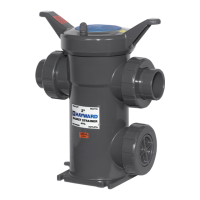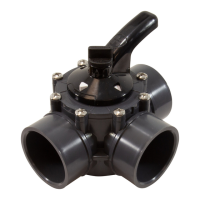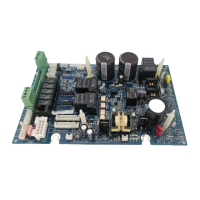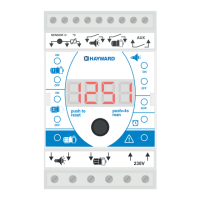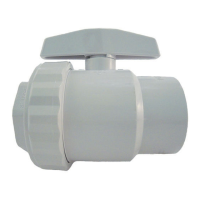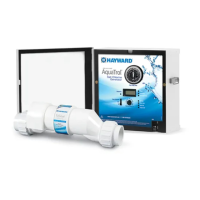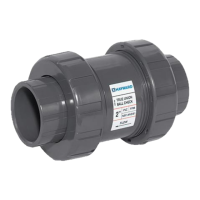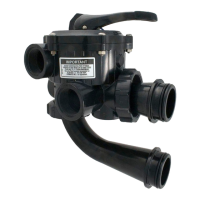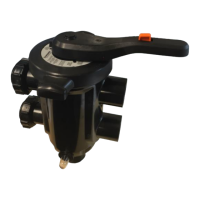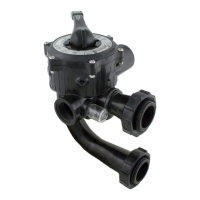Hayward Flow Control www.haywardflowcontrol.com 1-888-HAY-INDL (1-888-429-4635)
SBIOM Rev A 10/9/2019
Page 1 of 8
HAYWARD FLOW CONTROL
PVC, CPVC, & GFPP SB SERIES SIMPLEX BASKET STRAINER
INSTALLATION, OPERATION AND MAINTENANCE INSTRUCTIONS
PLEASE READ THE FOLLOWING INFORMATION PRIOR TO INSTALLING AND USING ANY HAYWARD PRODUCT. FAILURE TO FOLLOW
THESE INSTRUCTIONS MAY RESULT IN PRODUCT DAMAGE, PROPERTY DAMAGE, PERSONAL INJURY, OR EVEN DEATH.
1. Hayward Flow Control (Hayward), a division of Hayward Industries, guarantees its products against defective material and workmanship only.
Hayward assumes no responsibility for property damage or personal injury resulting from improper installation, misapplication, or abuse of any
product.
2. Hayward assumes no responsibility for property damage or personal injury resulting from chemical incompatibility between its products and the
process fluids to which they are exposed. Determining whether a particular PVC, CPVC, or GFPP product is suitable for an application is the
responsibility of the user. Chemical compatibility charts provided in Hayward literature are based on ambient temperatures of 70°F and are for
reference only.
3. Hayward products are designed for use with non-compressible liquids.
WARNING
Hayward PVC, CPVC, or GFPP products should NEVER be used or tested with compressible fluids such as compressed air or
nitrogen. Use of PVC, CPVC, or GFPP products in compressible fluid applications may result in product damage, property
damage, personal injury, or even death.
4. The maximum recommended fluid velocity through this Hayward product is five feet per second (5 ft/s). Higher fluid velocity can result in damage
due to the water hammer effect.
5. Piping systems must be designed and supported to prevent excess mechanical loading on Hayward products due to system misalignment, weight,
shock, vibration, and the effects of thermal expansion and contraction.
6. The effect of temperature on plastic piping systems must be considered when the systems are initially designed. The pressure rating of plastic
systems must be reduced with increasing temperature. Maximum operating pressure is dependent upon material selection as well as operating
temperature. Before installing any Hayward product, consult Hayward product literature for pressure vs. temperature curves to determine any
operating pressure or temperature limitations.
7. PVC, CPVC, and GFPP plastic products become less ductile below 34°F. Use caution in their installation and operation below this temperature.
WARNING
Hayward PVC and CPVC products should not be used in services with operating temperature below 34°F. Hayward GFPP
products should not be used in services with operating temperature below 20°F.
8. Due to differential thermal expansion rates between metal and plastic, transmittal of pipe vibration and pipe loading forces, DIRECT
INSTALLATION OF HAYWARD FLOW CONTROL PRODUCTS INTO METAL PIPING SYSTEMS IS NOT RECOMMENDED. Wherever
installation of Hayward product into metal piping systems is necessary, it is recommended that at least 10 pipe diameters in length of plastic pipe
be installed upstream and downstream of the product to compensate for the factors mentioned above.
9. Published operating requirements are based on testing of new products using clean water at 70°F. Performance is affected by many factors
including fluid chemistry, viscosity, specific gravity, flow rate, and temperature. These should be considered when sizing Hayward products.
10. Systems should always be depressurized and drained prior to installing or maintaining any Hayward product.
WARNING
Failure to depressurize and drain system prior to installing or maintaining any Hayward product may result in product damage,
property damage, personal injury, or even death.
11. Always follow your site and/or company procedures for any safety training and/or site specific precautions or warnings in addition to those in this
document.
The most recent revision to this document is available at http://www.haywardflowcontrol.com/images/flowcontrol/PDF/iom/SBIOM.pdf
